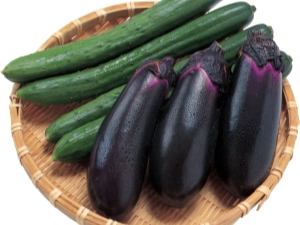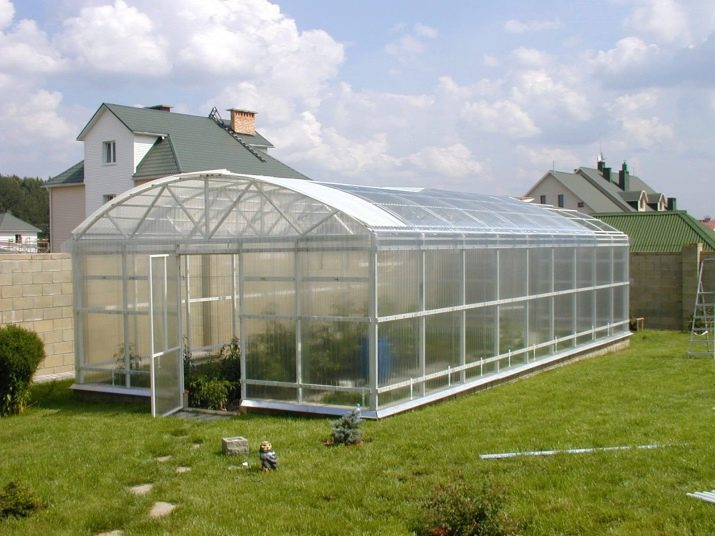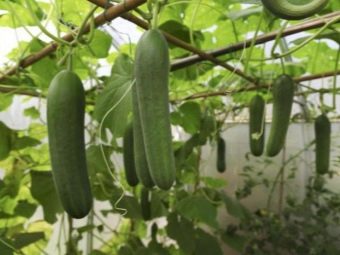Can I plant eggplants and cucumbers in the same greenhouse?

Eggplants and cucumbers are considered to be heat-loving plants.Not all regions allow creating optimal conditions for these crops when grown outdoors. Therefore, most vegetables are planted in greenhouses and greenhouses. At the same time, it is important to consider how favorable the neighborhood of these two plants is for each other.
Pros of joint landing
To know how positively the neighborhood of cucumbers and eggplants will affect the common greenhouse, It is necessary to specify the common conditions that are required for both cultures:
- Both plants need a greenhouse with high altitude;
- eggplants and cucumbers need access to sunlight;
- both vegetables prefer loose and light soil;
- when growing it is possible to introduce the same fertilizer;
- there are also no significant differences in the matter of their ripening period.
Of course, the main advantage is to save space in the country. By connecting two plants in the same greenhouse, you can get a good harvest.
Minuses
Alas, the cons in this neighborhood are also present. If they are not taken into account when caring for plants, the yield of both vegetables may decrease. Disadvantages relate to the differences of some conditions.
- Cucumbers require a lot of moisture. Their roots will absorb all the water and trace elements from the soil, leaving nothing for eggplants.
- Cucumbers must have cool air and humid air, they are grown at a temperature of about 20 degrees Celsius. Eggplants prefer to develop in a dry and hot atmosphere.
- Cucumbers can not be subjected to drafts. Eggplants, on the contrary, need to systematically organize airing.
However, the difference in the necessary conditions for growing in the circle of experienced gardeners is not considered such a large-scale problem. All these difficulties are completely solvable.
How to combine
Agronomists, faced with the complexity of the joint cultivation of cucumbers and eggplants, through trial and error, we developed several strict rules that will allow achieving a full-fledged harvest of both crops in the neighborhood of a common greenhouse.
- Eggplants are considered self-pollinating plants. To prevent related problems, it is recommended to purchase self-pollinating cucumber varieties.
- The most preferred planting scheme: cucumbers are located in the middle of the greenhouse, eggplants are planted on the sides. Similarly, cucumbers will not create a shadow for their light-loving neighbors, and eggplants will enjoy the high temperature and good light.
- If you put a film screen or a special mesh between the plots, this will provide the required temperature level, as well as prevent the spread of diseases.
- If in the neighborhood with eggplants to plant beans, it will enrich the earth with nitrogen, which is mandatory for both crops.
- Cucumbers are required to be tied up regularly so that they do not create a shadow for the eggplants.
- Ventilate the greenhouse for the formation of delicious eggplant should be in good weather. Only then will it not harm the cucumbers.
- To create moisture, so necessary for cucumbers, they can be carefully sprayed with water, without falling on the neighbors.
Top dressing and watering
It is recommended to water the plants in the morning or evening, when the intense heat is no longer terrible. Both cultures need to be watered at the root, but it is important not to overdo it with moisture. The abundance of water can lead to rotting of the root systems of cucumbers and eggplants. You also need to remember that the water should be quite warm.
Fertilizers can be made the same. Both vegetables respond well to feeding. The best option - humus or manure. Yeast is also a good remedy. They contain a large amount of nutrients.
For the first time, it is recommended to fertilize plants one week after planting the seedlings in the greenhouse.
Recipe for feeding:
- dissolve 20-25 g of yeast in a bucket of warm water;
- add a glass of wood ash, it will enrich the soil with minerals;
- put in a glass of bird droppings that saturate the soil with nitrogen;
- add 100 g of sugar, due to which the yeast will begin an active action;
- leave in a warm place for several hours;
- Dilute 1 L of the resulting solution in 10 L of water.
Watering the plants is recommended under the root after wetting, the yeast mixture activates the growth and development of root systems. In addition, the recipe is effective during flowering and fruiting.
Pest control
Neighborhood crops becomes a tasty prey for pests. Especially dangerous insects for both vegetables are aphid and spider mite. When these pests appear, you can resort to the following methods of control.
- Upon detection spider mite it is necessary to process the plants with acaricides at least 3 times. Only repeated spraying will avoid the recovery of the insect population. Also an effective way to cope with a tick is the tincture of potato tops. The method of use is the same.
- The best thing with aphids cope solutions of onion peel, wood ash, diluted with soap. Mixtures are suitable for both plants.
- Once planted, the main enemy of future young shoots becomes slug. In a more mature age, cucumbers have dense hairs on the leaves to protect the plant from insects. For eggplant slug is dangerous all season. To protect the future harvest, a small slate element can be placed on the plot in the greenhouse. Probably, on the same day a large number of snails and slugs will accumulate under it. After a few hours, the part can be turned over, crush the insects and put them back. After some time, other individuals will crawl to dine with their fellows. The leaves are unlikely to interest them. For a week this way you can rid the greenhouse from pests.
It is important to start the fight in time, before the insects have harmed the young shoots.
- Of the diseases most commonly affected are plants. gray rot. To get rid of it, you can prepare a mixture of chalk, water and potassium permanganate and lubricate the infected elements with the resulting ointment. To avoid the appearance of pests and diseases, it is necessary to carry out preventive measures in a timely manner, namely, to systematically monitor the condition of the leaves of cucumbers and eggplants, inspect them, and periodically process them with special solutions. The Bordeaux liquid, copper sulfate, cuproxat, Abiga-Peak, tsikhom showed themselves well in defense against diseases.
Other neighbors
The most frequent neighbors of cucumbers and eggplants are tomatoes and bell peppers. If we compare the extent to which the cultures fit together in joint cultivation, we can draw the following conclusions.
- Eggplant and Pepper beautifully combined. They prefer dryness and heat and require similar care. From cucumbers and peppers it turns out not very good neighborhood due to the difference in the required optimal temperature. In any case, it is important to avoid planting hot peppers, it will give the neighboring fruits a bitter taste.
- Eggplant and Tomato have poor compatibility, although they both belong to the nightshade. Tomatoes love moisture, which is similar to cucumber, and intense heat and dryness can cause a loss of the ovary. If you plant a number of water-loving cucumbers and tomatoes, the increased humidity in the greenhouse will lead to the spread of fungi and bacteria.
Eggplants rather favorably accept other heat-loving cultures. The most favorable neighbors for eggplant:
- salad;
- spinach;
- radish;
- bow;
- Chinese cabbage.
Cucumbers are pretty picky about their neighbors. The least successful option is to plant fragrant spicy herbs next to this vegetable. These include, for example, basil, cilantro and oregano.
Cucumbers have good compatibility with the following cultures:
- zucchini;
- radish;
- melons;
- beet.
If some cultures do not fit together well, then this does not mean that we should refuse to plant together.You just need to prepare for some of the subtleties of caring for plants, because each of them will require certain growing conditions.
Recommendations
If the novice summer resident decided to plant cucumbers and eggplants together, then should heed a few tips from experienced gardeners.
- If you install a greenhouse from natural materials, such as glass, the ripening time of the fruit will accelerate. Especially well you need to choose a place - the wind and precipitation should not harm the building.
- Before planting different crops next to each other, thoroughly disinfect the greenhouse with insecticidal agents.
- It is better to abandon top dressing with exclusively wood ash, since this substance washes away nitrogen from the soil, without which a good harvest will not turn out.
Certainly, it is better to grow eggplants and cucumbers separately, but not every gardener can boast a large area of the summer cottage. And if you take into account all the advice of experienced gardeners and grow crops together strictly by the rules, then at the end of the season the responsible grower will receive a high yield of eggplants and cucumbers.
About the best neighbors in the beds discussed in the next video.
































